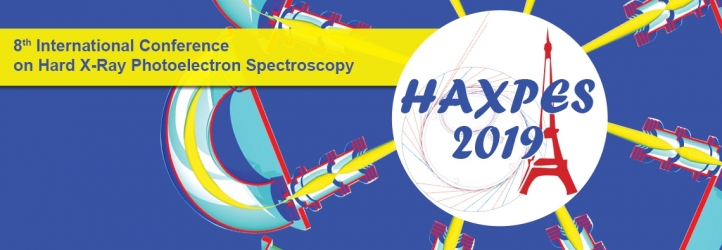
The GALAXIES beamline is dedicated to inelastic x-ray scattering (IXS) and hard x-ray photoemission (HAXPES). These spectroscopic techniques are powerful probes to characterize the electronic properties of materials. The beamline is optimized to operate in the 2.3 et 12 keV energy range with high resolution and micro beam.
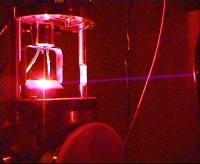 GALAXIES is an undulator beamline dedicated to hard x-ray spectroscopy. The main experimental techniques are:
GALAXIES is an undulator beamline dedicated to hard x-ray spectroscopy. The main experimental techniques are:
- Inelastic x-ray scattering (IXS)
- Hard x-ray photoemission spectroscopy (HAXPES)
Team
Employment
access to the SOLEIL employment web page
Technical data
2.3 – 12 keV
ΔE from 100 meV to 1 eV at 8 keV
In-vacuum U20 undulator
linear (H) ; with quarter wave plate : linear (V), circular
20 (V) x 80 (H) µm2 in standard mode, 5 (V) x 10 (H) µm2 in KB configuration
2-bounce fixed-exit monochromator (Si111); 4-bounce high-resolution monochromator (Si220 symetric and asymetric); collimating and focusing mirrors; 2 mirrors in KB configuration
1.5x1012 ph/s (standard foc.), 5x1011 (micro-foc.) at 8 keV
Si diodes, Avalanche diode
RIXS : 1-2m radius IXS spectrometer ; 0.5-1 m radius multi-analyzer setup (4x1 or 2x2)
HAXPES : high energy / high resolution electron analyzer (30 meV à 12 keV)
Scientific Opportunities
|
Hard condensed matter |
Strongly correlated electrons, superconducting materials; mixed-valent compounds and heavy fermions; interfaces and buried layers; More generally, rare earth and transition metal compounds, especially oxides. >> Resonant IXS, Resonant HAXPES, Auger spectroscopy. |
|---|---|
| Chimie |
Valence properties and local structure in metallic complexes; in-situ chemical analysis, catalysis, electrochemistry. |
| Géophysique, biophysique |
Magnetism under high pressure; K-edge of light elements in extreme conditions. |
Layout
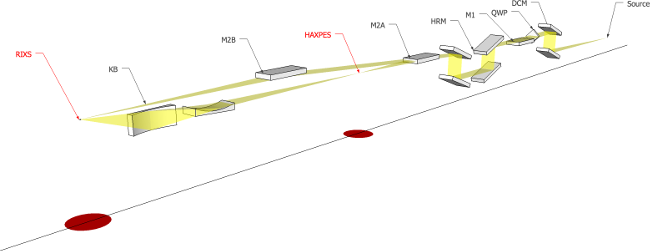
Overview
Beamline overview
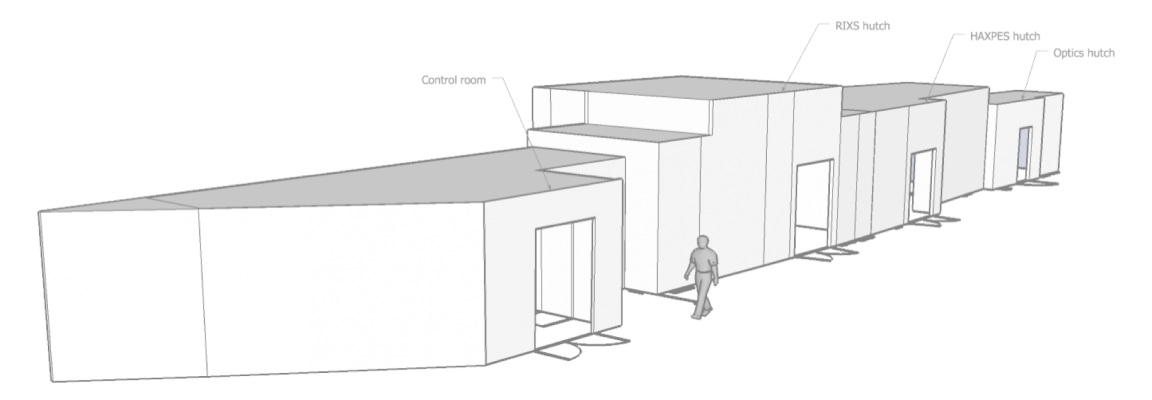
Optics Hutch 1
U20
Calculated flux : : 
Measured harmonics and accessible energy range : : 
DCM
2 x Si (111) pseudo channel cut
Energy range : 2.4 - 12 keV
Calculated resolution after the DCM:
|
E (keV) |
dE (eV) |
| 2.3 | 0.20 |
| 3 | 0.32 |
| 5 | 0.64 |
| 8 | 1.21 |
| 12 | 2.3 |
Experimental Hutch 1
HRM
- 4 x Si(220) (symmetric)
Calculated Resolution :

M1 collimating mirror
M1 has two different coatings :
- C for low energy (E < 6 keV)
- Pd for high energy (E > 6 keV).
Calculations of the reflectivity curves at 5 mrad :

M2A,B focusing mirrors
- Si toroidal mirrors with Pd coating
- Serve for focusing the beam onto the HAXPES (M2A) and RIXS (M2B) stations
HAXPES
Specifications
Hemispherical analyzer SCIENTA EW4000
Ec < 12 keV, resolution = 150 meV
Wide angular acceptance +/- 30°
Spot size : 80 x 30 μm2 (H x V)
Sample Environnement
Cryostat 20 K ARS for solid samples
LN2 cooled SCIENTA gas cell
HAXPES layout
The HAXPES station consists in an analysis chamber equiped with a 4-axes manipulator associated to a cryogenic system (20 K) for solid sample and a cell for measurements on gas phase. The analyzer is placed in the horizontal plane, at 90° from the incident beam. A preparation chamber, coupled to the analysis chamber, permits the in-vaccum transfert of samples. The chamber hosts an ion gun, evaporators and a LEED pour sample characterization. 
Sample holder
Standard Omicron-type plate (dimension en mm)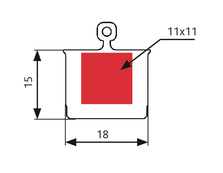
Specific holder for in-situ sample bias
The bias can be controlled by a Keithley 2450 sourcemeter purchased thanks to DIM-OxyMORE
Experimental Hutch 2
RIXS
Specifications
Newport RIXS spectrometer in Rowland circle geometry (diameter 0.5 to 2 m)
Energie range : ~4-12 keV
Available techniques : RIXS, NIXS, XES, PFY-XAS
Multianalyzer setup in a 4 x 1 ou 2 x 2 matrix
Spot size : 80 x 30 μm2 (H x V) [mode M2B] or 15 x 15 μm2 (H x V) [mode KB]
Sample Environnement
Diamond anvil cell (DAC)
Cryostat 10 K compatible with DAC
Spectrometer layout
The RIXS spectrometer is composed of two scattering arms working in the horizontal and / or vertical scattering plane, a detector arm and a sample stage.

Available analyzers
Last update : January 2014
| Crystal | Rayon | Emin* | Emax | Use** | Type |
| Si(111) | 1 m | 1977.35 (1) | 2103.93 (1) | Bent | |
| 5932.05 (3) | 6311.79 (3) | Cr Kβ, Gd Lα1, Tb Lα1, Cr K | |||
| 7909.40 (4) | 8415.72 (4) | Cu Kα1, Ni Kβ | |||
| 9886.74 (5) | 10519.65 (5) | Tl La1 | |||
| Si (220) | 1 m | 3229.00 (1) | 3435.70 (1) | K Kα1, nIXS | Bent diced |
| 6457.99 (2) | 6871.41 (2) | Mn Kβ, Mn K | |||
| 9686.99 (3) | 10307.1 (3) | Ge Kα1 | |||
| Ge (331) | 1 m | 4777.59 | 5083.43 | Ce Lα1, V Kα1, Pr Lα1 | Bent |
| Si (531) | 1 m | 6753.93 | 7186.29 | Co Kα1,Fe Kβ, Fe K | Bent |
| Si (620) | 1 m | 7220.26 | 7682.47 | Yb Lα1, Ni Kα1, Co Kβ | Bent |
| Si (533) | 2 m | 7486.12 | 7786.62 | Co Kβ, Co K | Bent |
| Si (551) | 2 m | 8152.82 | 8480.08 | Ni Kβ, Ni K | Bent |
| Si (553) | 2 m | 8768.97 | 9120.97 | Cu Kβ, Cu K | Bent |
| Ge(111)*** | 1 m | 1898.42 (1) | 2019.95 (1) | P Kα1 | Bent |
| 5695.26 (3) | 6059.85 (3) | Mn Kα1, Eu Lα1 | |||
| 7593.68 (4) | 8079.79 (4) | Co K, Co Kβ | |||
| 9492.10 (5) | 10099.74 (5) | Zn K, Zn Kβ, Ge Kα1 | |||
| Ge(220)*** | 1m | 3100.00 (1) | 3298.45 (1) | K Kα1 | Bent |
| 6199.99 (2) | 6596.89 (2) | Fe Kα1, Mn Kβ | |||
| 9299.99 (3) | 9895.34 (3) | Zn Kβ | |||
| Si(311) | 1m | 3786.34 (1) | 4028.72 (1) | I Lα1, Ca Kβ, Ca K | Bent |
| 11359.01 (3) | 12086.16 (3) | As K, Br Kα1 |
(*) the number in parenthesis indicates the order of reflection
(**) example of use
(***) analyzers purchased thanks to DIM-OxyMORE
M2B focusing mirrors
- Si toroidal mirrors with Pd coating
- Serve for focusing the beam onto the HAXPES (M2A) and RIXS (M2B) stations
References
Please use the following references when using the beamline equipments
Beamline
J.-P. Rueff, J. M. Ablett, D. Céolin, D. Prieur, Th. Moreno, V. Balédent, B. Lassalle, J. E. Rault, M. Simon, and A. Shukla, The galaxies beamline at soleil synchrotron: Inelastic x-ray scattering and photoelectron spectroscopy in the hard x-ray range, J. Synchrotron Rad. 22, 175 (2015).
HAXPES
D. Céolin, J.M. Ablett, D. Prieur, T. Moreno, J.-P. Rueff, B. Pilette, T. Marchenko, L. Journel, T. Marin, R. Guillemin, and M. Simon, Hard X-ray Photoelectron Spectroscopy on the GALAXIES beamline at the SOLEIL synchrotron, J. Elec. Spect. Relat. Phenom. 190, 188 (2013)
RIXS Multianalyseurs
F. Gélebart, M. Morand, Q. Dermigny, P. Giura, J.-P. Rueff, and A. Shukla, Large Solid Angle Spectrometer for Inelastic X-ray Scattering, AIP Conference Proceedings 879 (2007), no. 1, 1837.
HRM
J.M. Ablett, J.-M. Dubuisson, T. Moreno, D. Céolin, E. Raimon, D. Prieur, D. Corruble, J. Coquet, A. Lestrade, C. Bourgoin, and J.-P. Rueff, New Design Concept for a High-Resolution In-Vacuum 4-Bounce Hard X-Ray Monochromator at the GALAXIES Beamline at the SOLEIL Synchrotron, Journal of Physics Conferences Series, 425: art.n° 052007 (2013)
Commissioning
May 2012: First RIXS spectra
The first RIXS spectra were obtained on the GALAXIES beamline, completing the beamline installation for hard x-ray spectroscopy, in addition to HAXPES. The figure shows the Fe Kbeta fluorescence line obtained in a free-standing iron foil at 7.8 keV incident energy (Si(111) monochromator). We used a Si(531) spherically-bent crystal analyzer with a 1 m radius. The weak intensity is due to the air absorption, in absence of a He fly pass. The latter will be installed shortly with an expected gain of 2 to 3 orders of magnitude in intensity.
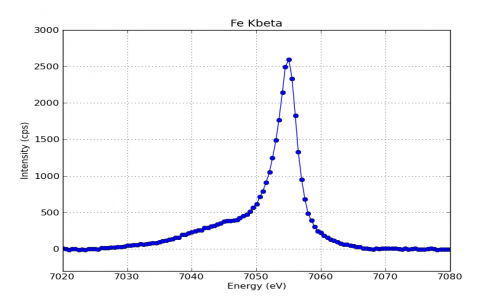
March 2012: First HAXPES spectra
The first HAXPES spectra have been obtained on GALAXIES at high kinetic energy using the SCIENTA EW4000 photoemission analyzer installed on the beamline The spectra below show the Au valence band (left) and Au 4f core level (right), measured at 9.84 keV incident energy, after the DCM 2 x Si(444) monochromator. In both cases, the pass energy was 200 eV. The measurements were caried out at room temperature. The spectral resolution is estimated to be around 250 meV.


July 2011: First absorption spectrum
The first absorption spectrum has been measured at the Pt L3-edge on a Pt foil using an ionization chamber located after the premonochromator (DCM). These first results show the beamline quality in terms of flux and resolution.

April 2011: First monochromatic beam
The first monochromatic beam on the GALAXIES beamline has been obtained in April 2011. The movie below shows the x-ray beam coming from the undulator and observed in false colors thanks to the x-ray imager located after the monochromator. Each picture corresponds to a different undulator gap while the patterns characterize the harmonics produced by the undulator. The measures have been realized at 9 keV by moving the undulator gap from 5.5 to 6 mm.
Installation
July 2010: First light on the GALAXIES beamline
The GALAXIES beamline has seen its first light this week during the radioprotection tests of the optical hutch. The white beam coming from the undulator creates a thin ray of light by ionizing the air molecules and impinges on the downstream imager. The tests have been realized for the first time at SOLEIL with a current in the ring of 500 mA. The tests achievement also gives the start signal for the installation of the scientific instrumentation on the beamline.
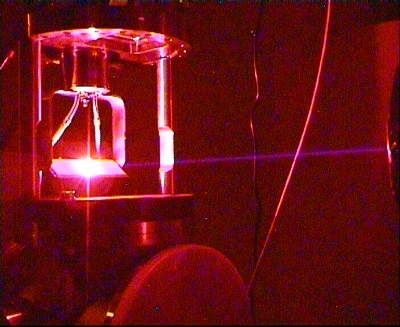
January 2010: Spectrometer RIXS
We have received in January 2010 a new instrument dedicated to inelastic x-ray scattering experiments (RIXS). The spectrometer has a original design based on 6-axis diffractometer from Newport. It is equiped with a 2m long arm to explore the scattering in a wide angular range in both horizontal et vertical planes, and a multi-analyzer setup which will be mounted on the short arm.
The instrument is to be mounted soon on the beamline;
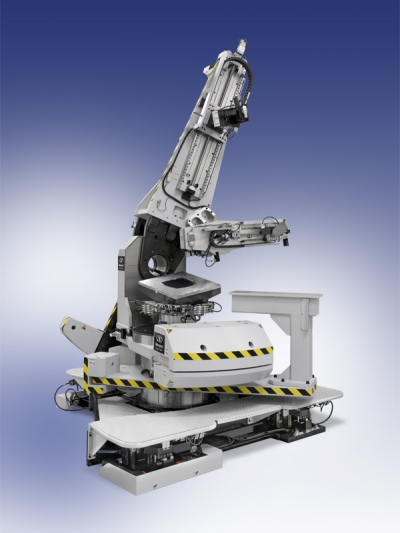
goniometre galaxies
November 2009 : Start of construction
The construction of the GALAXIES beamline has got off the ground since October 2009. The first optics hutch is already constructed; the experimental hutches will follow within the next weeks. End of construction is expected in December 2009.
First photos of the GALAXIES hutches:
 |
 |
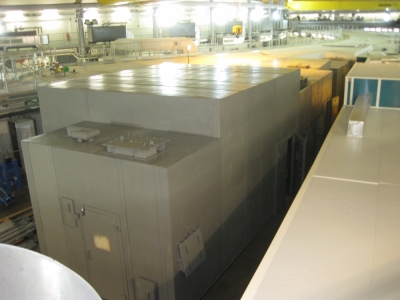 |
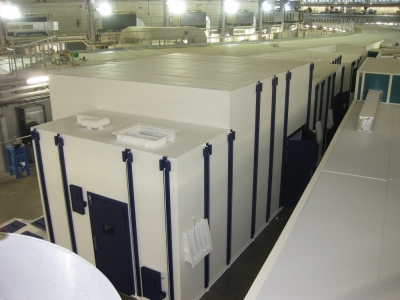 |



